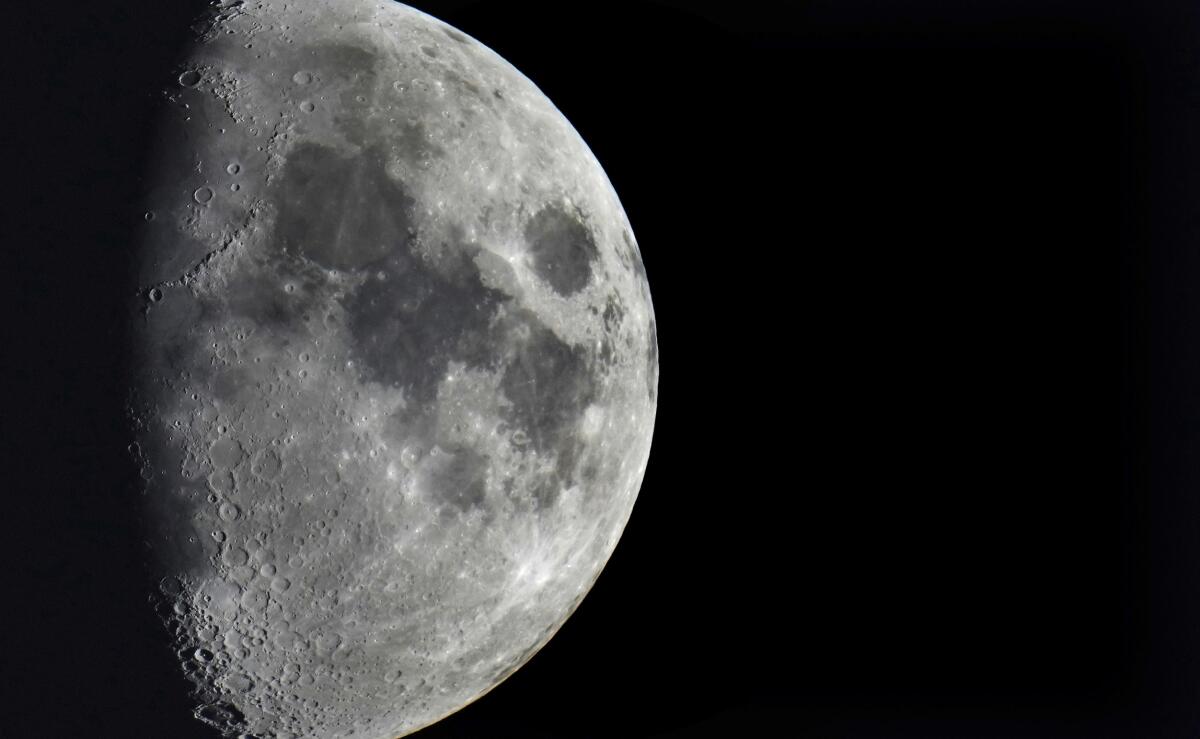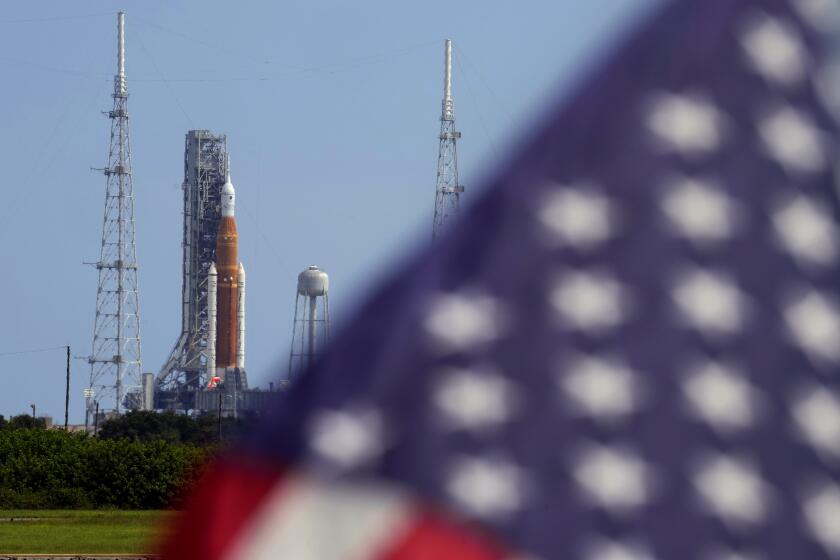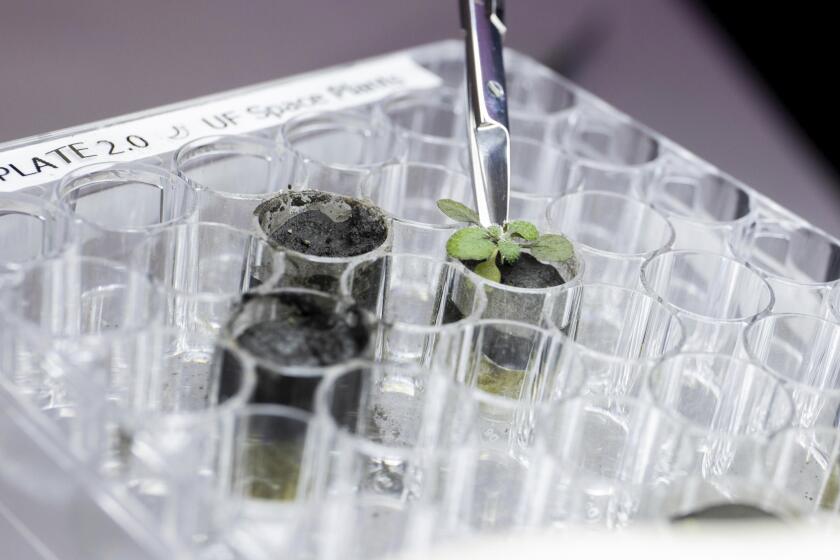Op-Ed: To the moon, again, with good reason

- Share via
The moon is full of meaning. Eons of culture attest to that, from its significance for religions to its inspiration for love songs, from keeping time to crafting myths out of the shapes we discern on its full face.
Our human journeys to the moon? Those meanings are more contested, less durable.
Fifty years after the last Apollo flight — and with the start of a new set of missions called Artemis — historians still argue about the meaning of putting humans on the moon.
Was it a geopolitical gamble that helped stifle the Soviet Union? Was it an exemplar of sublime technology? A waste of money best used to alleviate poverty? Or a force for educational and industrial inspiration? Probably all the above, in degrees. We harvest significance as we need it.
This week, NASA is making another attempt to get its Artemis missions off the ground. Tuesday night, at 10:04 p.m. Pacific time, a 120-minute launch window opens for the agency’s new rocket, the overbudget, overdue Space Launch System, crowned with an uncrewed Orion capsule, at the Kennedy Space Center in Florida.
Artemis 1 is meant to orbit the moon and test all systems before astronauts get involved. With Artemis 2, in 2024, humans will return to lunar space. After that, a landing.
More than two months ago, I kayaked through the Merritt Island National Wildlife Refuge in Florida, to a beach across from the Kennedy launch complex, hoping to see the rocket take off in person on NASA’s original Artemis launch date. Vultures skulked along the shore, manatees surfaced like gentle greetings and red plumes of standing cypress flowers foreshadowed rocket flames.
But because of fuel leaks and other problems, the SLS didn’t fly then or on its next attempt, a reminder that complex technological systems don’t necessarily cooperate with human desires. Apollo had its difficulties, too, and they were overcome. We shall see if Artemis’ can be as well.
There is a nationalist and technological nostalgia for the glory days of the Apollo missions — “If we can put a man in the moon, why can’t we…” But Apollo had its critics, and Artemis has its naysayers. What does Artemis proffer? they ask, citing the program price tag — $93 billion, among other criticisms.
NASA’s second attempt to launch its Artemis I mission was delayed again after a fuel leak.
How should those of us who believe that human lunar exploration is not a luxury but a necessity answer the critics? The easy response is that, in fact, we have barely explored the moon, humans having traversed just a few miles of its terrain. Rovers tell us a lot, but not as much as astronauts could. As to costs, it’s worth noting the U.S. spent more than $2 trillion in a failed war in Afghanistan. It’s also probable that other moon launches — private and by other nations — will lower the costs of future lunar forays.
The more complex answer, though, offers deeper meanings, tomorrow’s meanings, not just for Artemis but for the entire existential endeavor of our species.
We live on Earth — what writer and anthropologist Loren Eiseley called “the sunflower forest”— but we venture into what he named “the star fields” of space. These days we surely need both the humility engendered by life in the sunflower forest and the ambition, mastery and innovation space exploration imparts.
Indeed, something recently discovered underscores the moment: Water. On the moon.
Ancients called the blueish plains of the naked-eye moon “maria,” Latin for “seas.” But no tides trouble lunar beaches. The maria are solid lava. The moon water that science has located is frozen in the dark shadows of polar-region craters. This has sparked a global moon rush; scientists could use that ice as an archive, telling us more about the origins of the early solar system and the elements that eventually combined to make life as we know it. Lunar villagers could drink that water, breathe air extracted from it and use it to make rocket fuel too.
Scientists for the first time have grown plants in soil from the moon collected by NASA’s Apollo astronauts.
Recently, researchers at the University of Florida showed us something of what moon ice portends. Biologists Anna-Lisa Paul and Rob Ferl successfully raised Arabidopsis thaliana, a delicate-looking cress with tiny green leaves, in lunar “regolith” obtained from three Apollo missions. The fact that anything grew at all in the dark, moony stuff left Paul, in her words, “astonished.”
There, in photos, are green leaves birthed from non-Earth earth. A sprout of Eiseley’s metaphorical sunflower forest climbing toward the star fields. A sign that we can have our green world on new worlds, for sustenance at least and, less prosaically, as a reminder of the forests, savannahs, jungles and riverbanks where we came of age as intelligent primates.
I am what used to be called a “telescopist,” and I love contemplating the severe lunar landscape. As one 19th century lunar observer put it, I have “become in thought a lunar being.” Yet even I understand that we will need blossoms and leaves on the moon.
As we approach becoming multiplanetary, growing a green world up there might be the most important technology we develop, a way to craft new homecomings. Not to abandon Earth, but to spread its gifts, including, maybe, just maybe, the chance to rediscover an important skill: how to solve problems without creating new ones.
Christopher Cokinos’ book “Still as Bright: A Backyard Journey Through the Natural and Human History of the Moon” is forthcoming in 2024.
More to Read
A cure for the common opinion
Get thought-provoking perspectives with our weekly newsletter.
You may occasionally receive promotional content from the Los Angeles Times.











